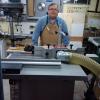I am moving into a new garage w/ 220 items. The welder is a HF (Don't judge me) vulcan 220. I have included what the specs say. My confusion is the manual also says that a 20A breaker is acceptable. Perhaps I am mis-interpreting current input as output as required current capacity?
1. The compressor says max current draw is 24A, why does it require a 40A breaker?
2. Am I mis-interpreting the current input as output data and is the 20A breaker ok for the welder?
Thanks much guys
Dave




 Reply With Quote
Reply With Quote


